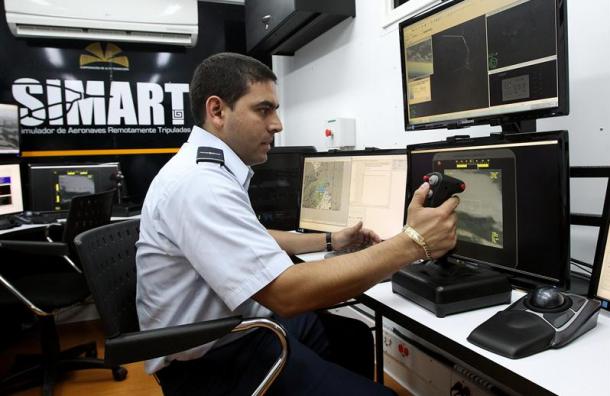Learning by doing in the virtual world
DOI:
https://doi.org/10.18667/cienciaypoderaereo.14Keywords:
B-Learning, digital tools, digital management tools, learning environment, meaningful learning, methodological strategies, virtual toolsAbstract
The following article is the product of research intended to identify methodological strategies to encourage graduate students to use virtual tools in their professional practice. This investigation was carried out through the use of the applied research model, which uses social cybernetics, and the experimental descriptive method, throughout the diagnostic, planning, and management phases. A common perception holds that the implementation of information and communications technology (ICT) is in itself sufficient to improve the education process, without regard for the supportive framework which allow an adult professional to commit to improving and developing enhancement of the skills that today's world requires. Furthermore, some believe that “learning by doing” educational experiences, based in ICT, are the key for the achievement of the proper use of technological tools, without paying attention to the teaching strategies which allow for effective learning of and with technology. After testing many strategies, which are detailed in the paper, the authors identify several tools which allow students to improve their level of knowledge of virtual culture, their use of technological language, and their motivation to approach ICT with greater confidence.
Downloads
References
Area, M. (2000). ¿Qué aporta Inernet al cambio pedagógico en educación superior. Disponible en http://ciberaula.es/quadrens/Hemeroteca/quaderns/sumario20/manuelarea.html Recuperado el 1 de 10 de 2009.
Bartolomé, A. (2004). Blended Learning. Conceptos básicos. Pixel-Bit, Revista de Medios y Educación, pp. 7-20.
Becerra, J. Y. (2002). La educación superior en entornos virtuales. Buenos Aires, Argentina: Quilmes Ediciones.
Burgos, A. L. (2007). Tecnología Educativa. México: Editorial Limusa.
Cabero, J. (2001). El rol del profesor ante las tecnologías de la información y la comunicación. Jornadas de formación: Centros de profesores y recursos, pp.83 - 94.
Castells, M. (1995). La ciudad inormacional: tecnologías de la información. Madrid, España: Alianza Editorial.
Díaz Barriga, F. y Hernández Rojas. (2002). Estrategias docentes para un aprendizaje significativo. México: Mc Graw Hill.
Dodge, B. (2002). Cinco Reglas para Escribir una Fabulosa WebQuest. Recuperado en 8 de octubre de 2007. Disponible en Eduteka: http://www.eduteka.org/Profesor10.php
________. (s.f.). Eduteka. Disponible en http://www.Eduteka.org Recuperado el 15 de 11 de 2009
Gabriel Restrepo, J. S. (2004). Hacia unos fundamentos de la enseñanza y el aprendizaje.
Gros, B. (1991). Inteligencia artificial: Diseño de programas educativos. Revista Española de pedagogía, pp.39 - 57.
Illera, J. L. (2004). La tecnología educativa en la enseñanza superior. Buenos Aires, Argentina: Homo Sapiens Ediciones.
_________. (2005). El aprendizaje virtual: enseñar a aprender en la era digital (Primera ed., Vol. 1). Santa Fe, Argentina: Homo Sapiens Editores.
Litwin, E. (2000). La educación a distancia: tema para el debate de una nueva agenda educativa. Buenos Aires, Argentina: Amorrotú.
Loscertales, J. C. (1998). ¿Cómo no ven los demás? La imagen del profesor y la enseñanaza en los medios de comunicación (Vol. 1). Sevilla: Secretariado de publicaciones de la Universidad de Sevilla.
Ossa, G. C. (2004). Herramientas para la migración de presencialidad a virtualidad en los docentes universitarios: Alternativas prácticas. Bogotá, Colombia.
Resnick, L. B. (1999). La educaciòn y el aparendizaje del pensamiento (Primera edición ed.). (M. Wald, Trad.) Buenos Aires, Argentina: Editorial AIQUE.
Romeo, M. (01 de 01 de 2002). Implementación telemática: retos y desafíos.forum telemático. Disponible en: http://www.ub.edu/forum/mmoreno.html Recuperado el 20 de marzo de 2009.
Sangra, A. (2002). ucación a distancia, educación presencial y usos de la tecnología: una triada para el progreso educativo. Edutec. Revista electrónica de tecnología educativa (15), 8.
Squeak, B. (s.f.). brey.blogia Bruner y el andamiaje., de brey.blogia. Disponible en: http://brey.blogia.com Recuperado el 7 de 12 de 2009.
Velandia, C. (2005). Modelo Pedagógico con fundamentos en cibernética social (Primera ed., Vol. 1). Medellín, Colombia: Educ.
Vieira, D. M. (2007). Tecnologías de la inteligencia: gestión de la intelibencia virtual. Madrid, España: Editorial Popular.
Vygosky, L. (1989). El desarrollo de los procesos psicológicos superiores. Barcelona: Critica.

Downloads
Published
Issue
Section
License
Assignment of Copyrights
Authors assign Ciencia y Poder Aéreo journal the exclusive rights (reproduction, distribution, public communication, and transformation) to exploit and commercialize their work, in whole or in part, in all the formats and modalities of present or future exploitation, in all languages, throughout the life of the work and throughout the world.
All contents published in Ciencia y Poder Aéreo journal are licensed under a Creative Commons Attribution 4.0 International License, whose complete information is available at http://creativecommons.org/licenses/by/4.0/
Under the terms of this license, users are free to download, print, extract, archive, distribute and publicly communicate the content of articles, provided that proper credit is granted to authors and Ciencia y Poder Aéreo, scientific journal of the Graduate School of the Colombian Air Force. Except when otherwise indicated, this site and its contents are licensed under a Creative Commons Attribution 4.0 International License.
For other uses not considered under this license it is required to contact the Director or the Editor of the journal at the e-mail address cienciaypoderaereo1@gmail.com.
The Graduate School of the Colombian Air Force and this publication are not responsible for the concepts expressed in the articles, including the metadata or the affiliation stated by authors. This is the full responsibility of the authors.





















